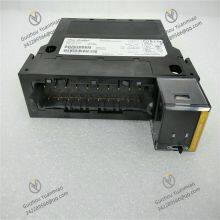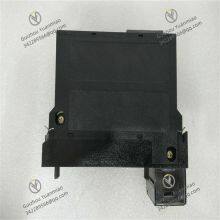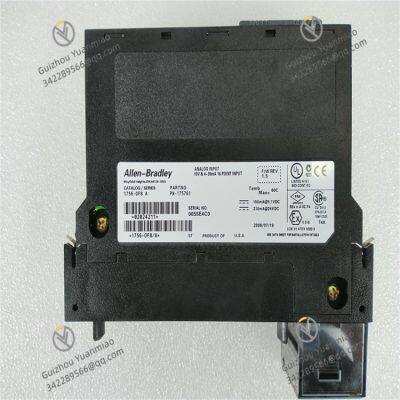Material
Other, Global universal model
Condition
Other, Global universal model
Task
Other, Global universal model
Mathematical Model
Other, Global universal model
Signal
Other, Global universal model
Customized
Non-Customized
Structure
Other, Global universal model
Operating temperature
0°C to 60°C
Humidity
5% - 95% (non - condensing)
Power Input
24V DC
I. Overview
1756-OF8 is a high-performance analog output module in Rockwell Automation's ControlLogix series. It is mainly used to convert digital signals from the control system into continuous analog signals to drive actuators that require analog control in industrial sites, serving as a key component connecting digital control systems and analog actuators.
This module can be seamlessly integrated with ControlLogix series controllers (such as 1756-L73, 1756-L84ES, etc.) and provides 8 independent analog output channels. It is suitable for industrial scenarios that require continuous adjustment of parameters such as flow, pressure, temperature, and speed, such as chemical production process control, precision machining, and HVAC (heating, ventilation and air conditioning) systems. With its high-precision output performance and stable operation, it provides strong support for the precise control of industrial automation systems.

II. Technical Parameters
Output channels: Equipped with 8 independent analog output channels, which can simultaneously adjust 8 actuators requiring analog control. It meets the needs of multi-parameter collaborative control in small and medium-sized automation systems, improving the control accuracy and flexibility of the system.
Output signal types: Supports various common analog output signal types, including 4mA - 20mA DC current signals and 0V - 10V DC voltage signals (specific signal types are subject to the product manual). It can be flexibly selected according to the needs of different actuators, adapting to devices such as control valves, frequency converters, and servo valves.
Output accuracy: Features high output accuracy, with an error usually within ±0.1% of full scale (specific accuracy is subject to the product manual). It ensures that the output analog signal accurately reflects the commands of the control system, realizing precise adjustment of the actuator.
Resolution: Has a high resolution, generally up to 16 bits (specific resolution is subject to the product manual), enabling fine adjustment of the output signal. It meets scenarios with high requirements for control accuracy, such as temperature control in precision chemical reactions and speed adjustment of high-precision machine tools.
Electrical isolation: An electrical isolation design is adopted between the output channels and the backplane bus, with an isolation voltage usually reaching more than 2500V AC. It effectively blocks external interference signals from entering the control system, prevents high voltage and large current from damaging the module and controller, and ensures stable operation of the system. Some models may also have isolation between channels to avoid mutual interference between channels.
Response time: The response time of the output signal is short, usually at the millisecond level, which can quickly respond to changes in the control system's commands, ensuring timely adjustment of the actuator to meet the needs of dynamic control processes.
Power supply requirements: Powered by the power module of the ControlLogix rack, with a typical supply voltage of 5V DC. It has low power consumption, has little impact on the system power load, and is convenient for system integration and installation.
Environmental adaptability:
Operating temperature: Can work stably within the temperature range of 0°C - 60°C, adapting to common temperature fluctuations in industrial sites.
Relative humidity: Can operate normally in a relative humidity environment of 5% - 95% (non-condensing), suitable for humid production workshops and other environments.
Vibration and shock resistance: Complies with relevant industrial standards such as IEC 61131-2, has certain vibration and shock resistance capabilities, and can work reliably in industrial occasions with slight vibrations (such as near production lines and pump sets).

III. Functional Characteristics
High-precision output: With high output accuracy and high resolution, it can accurately output analog signals, ensuring that the actuator performs precise actions according to the commands of the control system. For example, it can stabilize the temperature of the reactor within ±0.5°C of the set value, improving the quality stability of the industrial production process.
Flexible signal configuration: Supports multiple analog output signal types. Users can flexibly configure the output signal type of each channel through programming software according to the requirements of the actuator. It can adapt to different devices without replacing the module, reducing the difficulty of system integration.
Effective electrical isolation: The multiple electrical isolation design can not only prevent external electromagnetic interference from affecting the stability of the output signal but also avoid damage to the module and control system caused by external circuit faults. It enhances the safety and anti-interference ability of the system, ensuring long-term stable operation of the system.
Comprehensive diagnostic functions: Equipped with complete self-diagnostic functions, which can real-time monitor the operating status of the module and each output channel, such as output signal overrun and channel failure. When an abnormality is detected, it will promptly send an alarm signal and upload the fault information through the controller, facilitating maintenance personnel to quickly locate and eliminate faults, and improving the maintainability of the system.
Convenient installation and integration: Adopts a standardized rack mounting method, with a simple and fast installation process. It can be flexibly combined with other modules in the ControlLogix series (such as input modules, controllers, etc.) to form a complete automation control system. At the same time, the module is compatible with Rockwell Automation's Logix Designer programming software, facilitating users to configure signal types, calibrate parameters, and debug programs, realizing seamless connection with the entire automation system.
Temperature compensation function: Some models have a temperature compensation function, which can automatically correct the deviation of the output signal within a certain temperature range. It ensures that the output accuracy is not affected in industrial environments with large temperature changes, maintaining a stable control effect.

IV. Common Faults and Solutions
Inaccurate output signal
Phenomenon: The analog signal output by the module does not match the controller's command, with a large deviation, causing abnormal action of the actuator and failure to achieve the expected control effect.
Causes and solutions:
Calibration issues: The module may have calibration deviations after long-term use. Re-calibrate the module using Rockwell Automation's programming software, adjust the zero point and full scale according to the calibration process to ensure accurate output signals.
Incorrect wiring: Check whether the wiring of the output signal is correct, and whether there are loose connections, poor contact, or reversed polarity. Re-tighten the wiring, correct wiring errors, and ensure smooth signal transmission.
External interference: There is strong electromagnetic interference (such as frequency converters, large motors, etc.) around the module, affecting the stability of the output signal. Take shielding measures (such as using shielded cables, adding grounding, etc.) to reduce the impact of electromagnetic interference on the signal.
No output signal
Phenomenon: The controller has sent a control command, but the module has no analog signal output, and the actuator does not act.
Causes and solutions:
Power failure: Check whether the power supply voltage of the module is normal (such as 5V DC), whether the power module is damaged, or whether the power supply line is broken or has poor contact. Use a multimeter to measure the power supply voltage, replace the damaged power module or repair the power supply line to ensure normal power supply.
Incorrect channel configuration: Check whether the channel configuration of the module in the programming software (such as signal type, output range, etc.) is correct. Reconfigure the parameters correctly, download the program, and test again.
Module hardware failure: If the power supply and configuration are normal, the internal circuit of the module may be damaged. Contact professional maintenance personnel for inspection and replace the module if necessary.
Large fluctuation of output signal
Phenomenon: The analog signal output by the module is unstable and fluctuates frequently, causing the actuator to act frequently, affecting control accuracy and equipment life.
Causes and solutions:
Poor grounding: Poor grounding of the module or signal lines introduces interference signals. Check the grounding lines to ensure that the grounding of the module, actuator, and control system is reliable and meets specifications (such as single-point grounding) to reduce grounding interference.
Excessively long lines or impedance mismatch: Excessively long output signal lines or mismatched cable impedance with the actuator lead to signal attenuation or reflection. Replace cables of appropriate specifications, shorten the line length, or add signal amplifiers, impedance matchers, and other devices in the line.
Actuator failure: Internal faults in the actuator (such as stuck control valves, abnormal sensors, etc.) cause abnormal signal feedback, indirectly causing fluctuations in the module output. Inspect the actuator, repair or replace faulty components.
Module communication failure
Phenomenon: The module cannot communicate with the controller, the controller cannot configure the module or send commands, and the module status information cannot be uploaded.
Causes and solutions:
Loose connection: Check whether the connection between the module and the rack is firm and whether the backplane bus has poor contact. Re-plug the module to ensure reliable connection.
Mismatched communication parameters: Confirm whether the communication parameters of the module (such as address) are consistent with the settings of the controller. Reset the module communication parameters in the programming software to match the controller.
Module hardware failure: If the connection and parameters are normal, the communication interface of the module may be damaged. Contact professional maintenance personnel for inspection and replace the module if necessary.














































